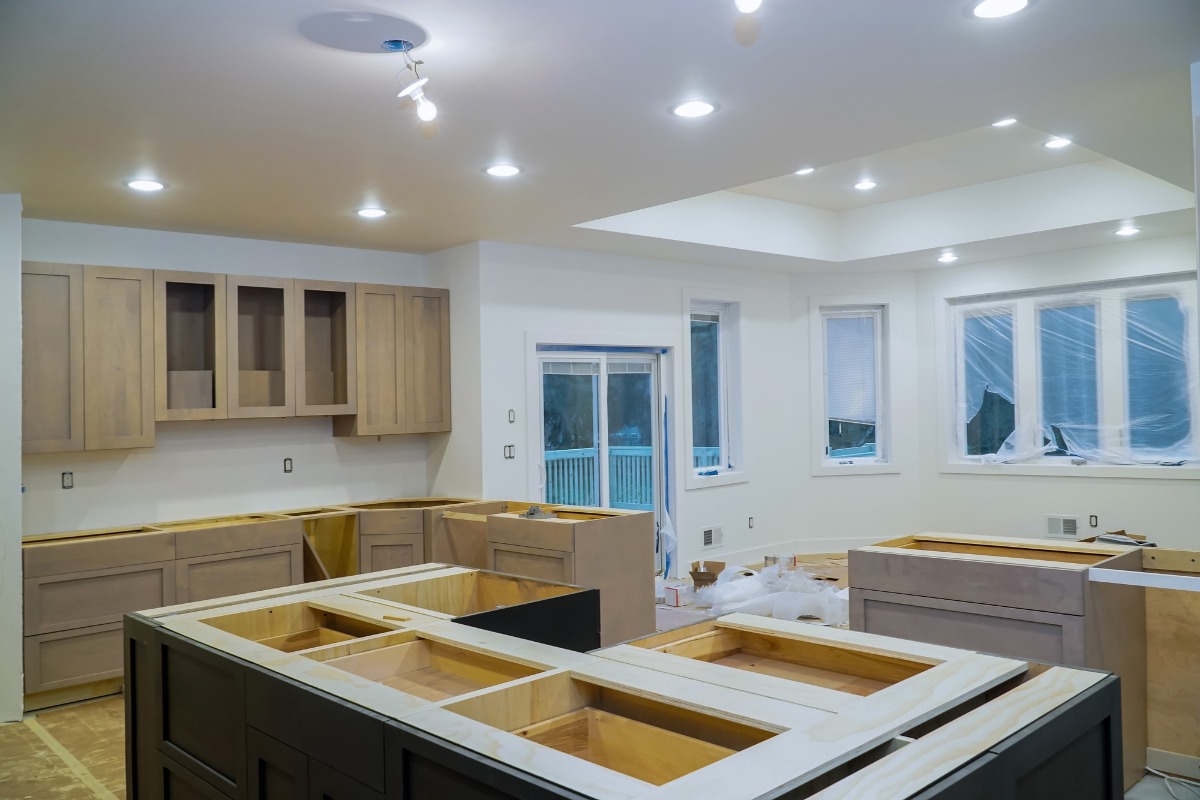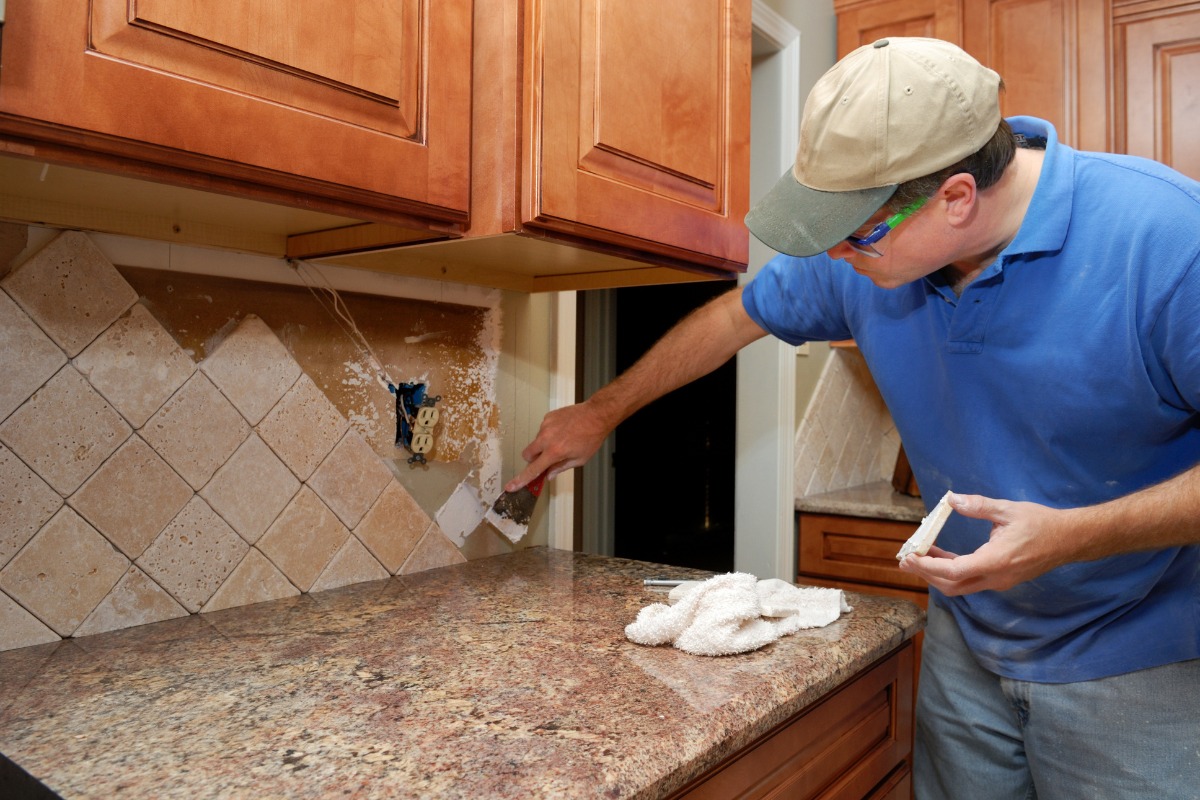In our quest for a sustainable home, we often overlook the hub of our daily lives—the kitchen. An eco-friendly kitchen remodeling project stands as a testament to our commitment to the environment, ushering in an age of environmentally friendly kitchen renovation practices that redefine the heart of the home. We understand that green kitchen remodeling efforts extend beyond aesthetics; they are a pledge to the ethos of conservation and responsible living. By focusing on water and energy efficiency and deploying sustainably sourced materials, we can substantially lower our ecological footprint. It’s our shared journey to cultivate a space that is not just an intersection of design and functionality but also a beacon of sustainability and ethical responsibility.
Key Takeaways
- Implement energy-efficient solutions to align your kitchen with a sustainable home philosophy.
- Incorporate water-saving fixtures and appliances for a more eco-friendly kitchen footprint.
- Opt for durable, sustainably sourced materials, supporting the long-term vision of environmentally friendly kitchen renovation.
- Select non-toxic products to ensure a healthy living environment during and after your green kitchen remodel.
- Consider holistic sustainability by choosing designs and materials that minimize waste and pollution.
- Work with like-minded professionals who prioritize eco-friendly kitchen remodeling as a core value.
Finding the Right Contractor for Your Eco-Friendly Kitchen Remodelling

Embarking on an eco-conscious kitchen renovation journey requires not just a vision but also a team that understands and shares your commitment to sustainability. This is why we emphasize the importance of partnering with a contractor who specializes in sustainable kitchen makeovers. Premier Pro Builders, lauded for their work in Los Angeles, are seasoned experts in transforming kitchens into environmentally friendly spaces without compromising on style or functionality.
When searching for the ideal contractor, we often look to resources such as The Green Home Guide’s “Find a Pro” section, which connects homeowners with professionals adept in green building practices. It’s crucial to choose someone with a portfolio that demonstrates their proficiency in integrating non-toxic, eco-friendly products and technologies seamlessly into their work.
A reliable contractor, like Premier Pro Builders, benefits your project in myriad ways, from sourcing sustainable materials to employing methods that reduce waste and energy use during construction. Their expertise is evident in every meticulous detail—from advising on the best low-emission finishes to installing energy-efficient appliances that harmonize with your eco-friendly ethos.
Below, you’ll find a table that outlines the factors to consider when selecting your contractor for an eco-conscious remodel in Los Angeles:
| Factors to consider | Details | Benefits |
|---|---|---|
| Eco-Friendly Expertise | Knowledge of materials, energy efficiency, and water conservation | Ensures sustainability is at the core of your kitchen design. |
| Experience with Local Suppliers | Access to sustainable, locally sourced materials | Supports local businesses and reduces the carbon footprint. |
| Portfolio of Past Projects | Demonstrated success in green building | Confirms capability and experience in eco-friendly construction |
| Customer Testimonials | Feedback from previous clients | Provides real-life evidence of customer satisfaction. |
Remember, your choice of contractor will significantly influence the outcome of your sustainable kitchen makeover. As you plan your project, consider reaching out to Premier Pro Builders (phone number 8183004339) to explore how they can be an invaluable asset in achieving your vision for an eco-conscious renovation in Los Angeles.
Eco-Friendly Kitchen Remodelling Materials and Finishes
Embarking on a sustainable kitchen renovation means prioritizing materials and finishes that are not just aesthetically pleasing but also environmentally responsible. We recognize the impact that our choices have on the planet, and we carefully select eco-friendly kitchen design elements that align with this commitment. From the surfaces we prepare our meals on to the cabinets that store our kitchen essentials, we focus on using high-quality, renewable resources to create a space that reflects both our values and our style.
Countertops: A Spotlight on Sustainability
Countertops are more than just workspaces; they’re a statement about our eco-conscious choices. We recommend quartz for its durability and the fact that it requires less impactful mining practices. But our commitment doesn’t stop there. We also explore other sustainable alternatives like recycled glass and resin, both of which offer unique beauty without taxing the environment.
Cabinets: Building for Health and Longevity
To ensure that our cabinets contribute to a healthy and durable kitchen, we opt for FSC-certified cabinets, which guarantee that the wood has been harvested sustainably. In our search for non-toxic materials, we avoid products containing formaldehyde and other volatile organic compounds, turning instead to solid wood, bamboo, and even recycled wood choices to support sustainable living.
Achieving a Green Backsplash
A backsplash might be a small component of the kitchen, but it holds tremendous potential for sustainable impact. We believe in utilizing recycled materials, such as glass tiles, to provide durability and a touch of elegance without compromising our environmental principles. Moreover, these recycled appliances are not only eco-friendly, but they carry the narrative of reduced waste and mindful consumption into the walls of our kitchens.
Maximising Water Efficiency in Kitchen Design

As we continue to embrace water-efficient kitchen design, it’s pivotal that we consider the fixtures that play a significant role in water usage. A fixture that has steadily gained recognition for its efficiency is the low-flow faucet, renowned for its ability to cut down water consumption by upwards of 30% without compromising on functionality. When embarking on eco-friendly kitchen upgrades, selecting faucets that bear the WaterSense label is not just a smart choice; it’s a commitment to environmental stewardship and long-term savings.
Adopting this eco-friendly route in our kitchens brings with it the benefit of aligning our household habits with conservation efforts on a larger scale. Below, we’ve outlined a comparison of standard faucets versus WaterSense-labelled low-flow alternatives to illustrate the remarkable differences and potential savings:
| Faucet Type | Flow rate (gallons per minute) | Annual Water Usage (gallons) | Estimated Savings (%) |
|---|---|---|---|
| Standard Kitchen Faucet | 2.2 | 15,700 | — |
| WaterSense-Labelled Faucet | 1.5 | 10,700 | 32 |
As depicted in the table, the shift from a standard faucet to a WaterSense-labelled faucet not only drastically reduces the water flow rate but also contributes to a significant annual reduction in water consumption, translating to noticeable savings on utility bills. This is a testament to the impact that making mindful product selections can have on both our environment and household expenditures. Moreover, these water-saving fixtures integrate seamlessly into any kitchen design, proving that water efficiency need not come at the expense of aesthetic appeal or functionality.
- Choose faucets with aerators to maintain water pressure while reducing flow.
- Integrate smart dishwashers that optimize water use based on load size.
- Implement water recycling systems to repurpose grey water for other uses.
We believe that thoughtful consideration of our water use in kitchen design is not just a trend but an essential step in the journey towards a more sustainable lifestyle. By selecting the right fixtures and appliances, we demonstrate our support for vital water conservation efforts and play an active role in the movement towards a more eco-friendly future.
Integrating Energy-Efficient Lighting Solutions
Embarking on an energy-efficient kitchen remodeling project offers an excellent opportunity to enhance the aesthetic appeal of your space while also prioritizing sustainability. A key element in achieving this is the smart integration of lighting solutions that are both cost-effective and eco-friendly. We understand the pivotal role that lighting plays in the functionality and ambiance of your kitchen. Therefore, we emphasize the incorporation of LED lighting, skylights, and tubular daylighting systems to illuminate your space effectively while minimizing energy consumption.
Natural Light: The Benefits and How to Harness Them
Natural lighting is a cornerstone of energy-efficient design, and its advantages go beyond just energy savings. It energizes the kitchen area with a warm, welcoming glow that is unmatched by artificial sources. To harness these benefits, installing skylights and tubular daylighting systems can significantly enhance the amount of natural light in your kitchen. These features not only decrease the reliance on electric lighting during the day but also provide an open and airy feel that can make your space appear larger and more inviting.
Transitioning to LED: Longevity and Energy Savings
When natural light is insufficient, LED lighting steps in as the next best option. It’s a game-changer in terms of energy efficiency and longevity, which are crucial for sustainable kitchen designs. Transitioning to LED lighting is a strategic move that provides a high-quality lighting experience and remarkable reductions in energy bills. LEDs also boast an impressive lifespan, significantly reducing the frequency of bulb replacements. By opting for LED fixtures, we also expand design possibilities with a variety of colors and dimming capabilities to cater to different moods and tasks within your kitchen.
In our extensive experience with energy-efficient kitchen remodeling, we have found that a combination of natural and LED lighting not only enhances energy efficiency but fundamentally transforms the kitchen environment. Our commitment to integrating these sustainable lighting options reflects our dedication to providing homeowners with kitchen spaces that are both beautiful and kind to the environment.
Selecting Energy-Efficient Appliances for a Modern Kitchen
When we embark on the journey to create an updated kitchen, choosing modern induction range tops and convection ovens is not just a nod to contemporary style but a commitment to eco-friendly living. These state-of-the-art appliances pave the way for a kitchen that is not only sleek and sophisticated but also remarkably efficient in its energy use. Loaded with the latest in cooking technology, they offer precise temperature control and faster heating times, reducing the energy consumption of your culinary endeavors.
Another cornerstone of our eco-friendly kitchen appliance arsenal is the reputable Energy Star certification—a symbol of optimal efficiency. Appliances boasting this label meet the strict energy efficiency guidelines set by the U.S. Environmental Protection Agency, ensuring that your kitchen’s energy demand is significantly lowered. Here’s a breakdown of the top eco-friendly kitchen appliances that combine high performance with energy conservation:
| Appliance | Features | Energy Star Certified |
|---|---|---|
| Induction Range Top | Fast heating, precise control, and a cooler kitchen environment | Yes |
| Convection Oven | Even baking, quicker cooking times, and better energy distribution | Yes |
| Dishwasher | Improved water efficiency, advanced soil sensors, eco-wash cycles | Yes |
| Refrigerator | Programmable temperature controls, better insulation, and efficient lighting | Yes |
The allure of these advanced home technologies extends well beyond their functionality. By incorporating them into our kitchens, we are making a conscious choice to steward our resources responsibly. It is a testament to the fact that we need not sacrifice luxury for sustainability—indeed, with these energy-efficient innovations, we enhance our quality of life while upholding our commitment to the environment.
Low-VOC Products: Paints, Finishes, and Coatings for Healthier Kitchens

As we delve into the realm of environmentally friendly kitchen renovation, our focus inevitably turns to the quality of the air we breathe within our homes. It’s a well-established fact that volatile organic compounds (VOCs) can compromise indoor air quality, leading to potential health risks. This is where low-VOC kitchen products secure their vital role in both our well-being and our commitment to non-toxic kitchen design.
Selecting the correct low-VOC products isn’t just a matter of scanning labels for the “low-VOC” tag; it requires a deeper understanding of what goes into the products we choose for our kitchens. Here, we provide a comprehensive guide, ensuring that every layer of your kitchen finish supports a healthier lifestyle while contributing to an overall environmentally friendly kitchen renovation.
| Product Type | Description | Health Benefits | Brands to consider |
|---|---|---|---|
| Low-VOC Paints | Paints with reduced levels of volatile organic compounds. | Minimises respiratory issues and headaches; safer for families. | Benjamin Moore, Sherwin-Williams |
| Non-toxic Sealants | Sealants are free from harmful chemicals or solvents. | It prevents off-gassing and enhances indoor air quality. | AFM Safecoat, Green Building Supply |
| Eco-friendly Stains and Finishes | Products using natural oils and waxes without VOCs. | Protects air quality; there is no toxic fume release during application. | Eco Safety Products, Earthpaint |
Paints and finishes are more than cosmetic enhancements; they are a barrier between our families and the structural materials often treated with chemicals. By choosing low-VOC kitchen products, we make a conscious effort to shield our homes from substances that, while invisible, can have a lasting impact on our health and environment. Navigate the path to an environmentally friendly kitchen renovation with confidence, understanding that each selection you make in pursuit of a non-toxic kitchen design is a stride towards a sustainable and healthy future.
Choosing Sustainable Flooring Options
When we commit to an eco-friendly kitchen design, selecting the right sustainable flooring becomes a cornerstone of our renovation plans. The flooring choices we make today will impact not only the look and feel of our kitchen but also the future of our planet. Thankfully, the market now offers a wide range of beautiful, sustainable flooring materials that pair ethical sourcing with high-end design aesthetics.
Wood: Balancing Ethics with Aesthetics
The classic warmth of wood flooring is irreplaceable, and by choosing FSC-certified wood, we can ensure that our kitchen’s beauty does not come at the cost of the environment. The Forest Stewardship Council (FSC) sets standards for responsible forest management, guaranteeing that the wood we select for our flooring comes from sustainably managed forests. Reclaimed wood is another excellent option that brings history and character to our kitchens while being an environmentally sound choice.
Cork and Bamboo: The New Eco-Flooring Standards
Advancements in eco-friendly materials have brought cork and bamboo flooring to the forefront of sustainable kitchen redesign. Cork, harvested from the bark of cork oak trees without harming the tree itself, is not only a renewable resource but also provides a naturally cushioned surface underfoot. Bamboo, with its rapid growth cycle, is another resilient and sustainable flooring choice. Both cork and bamboo reflect the latest trends in eco-friendly kitchen design, offering durability and a modern look while upholding our commitment to the planet.
Innovative Eco-Friendly Kitchen Design Layouts
As we delve into the realm of sustainable kitchen makeovers, our focus extends beyond the selection of materials and appliances. We recognize that the foundation of a truly green kitchen renovation is not only reflected in what we add but also in the spatial blueprint we conceive. A timeless kitchen design is not a passing trend; it’s a commitment to creating a space that harmoniously evolves with our changing lifestyles and needs. By considering the full lifespan of the kitchen layout and its components, we contribute to the longevity of our environment, reducing the cycle of waste and consumption.
In our pursuit of sustainability, we craft kitchen designs that serve multiple generations. The goal of a green kitchen renovation is to strike a balance between aesthetic allure and functional pragmatism, ensuring that the heart of the home is not only inviting but adaptable. This might mean incorporating adjustable and modular elements that can be reconfigured as the family dynamic shifts, maintaining both the kitchen’s relevance and its environmental integrity. Through smart design choices, we strive to minimize future alterations, which, in turn, lowers the impact on our precious resources.
When envisioning the sustainable kitchen makeovers of tomorrow, we envision spaces that are meticulously planned with eco-friendly principles at their core. It’s a holistic approach where timeless kitchen design facilitates ease of movement, maximizes accessibility, and embodies the principles of universal design. Every square inch is a testament to our commitment to creating spaces that don’t just follow trends but define them without compromising the well-being of our planet. Such thoughtful design resonates with the essence of a green kitchen renovation—a nexus where form gracefully meets function, crafted to stand the test of time.
Innovative Eco-Friendly Kitchen Design Layouts
What are some eco-friendly kitchen remodeling tips for a sustainable home?
To create a sustainable and eco-friendly kitchen, focus on water and energy efficiency, use sustainably sourced materials, and choose low-toxicity finishes. Incorporating salvaged or recycled elements, opting for Energy Star appliances, and designing with long-term use and flexibility in mind are also key strategies.
How do I find a contractor who specializes in eco-conscious kitchen renovations?
Look for contractors with a track record of green renovations, such as those listed in The Green Home Guide’s “Find a Pro” section. You can also ask local green building suppliers for recommendations. Consider checking with local contractors like Premier Pro Builders in Los Angeles to gauge their expertise in sustainable kitchen makeovers.
What are the most sustainable materials to use for kitchen countertops?
Quartz is a sustainable choice for countertops due to its less intensive mining process and durability. Other environmentally friendly options include recycled glass, paper composites, and sustainably harvested wood.
How can I ensure my kitchen cabinets are eco-friendly?
Choose cabinets made from sustainably sourced or recycled wood and those that are certifiably free of toxic chemicals like formaldehyde. Look for FSC-certified wood or bamboo for an added green stamp of approval.
What types of backsplash materials are considered green?
For a green backsplash, consider using recycled tile, glass, or sustainable materials like biodegradable cork or responsibly quarried natural stone.
What fixtures can I install to improve water efficiency in the kitchen?
Install low-flow faucets and fixtures with the WaterSense label to significantly reduce water usage without impacting performance, as part of your eco-friendly kitchen upgrades.
How can I use natural light to improve my kitchen’s energy efficiency?
Increase your use of natural light with strategically placed windows, skylights, or tubular daylighting systems. These methods can help reduce reliance on artificial lighting during the day.
Why is transitioning to LED lighting beneficial for my kitchen?
LED lighting is highly energy-efficient, reduces electricity consumption, has a longer lifespan than traditional bulbs, and requires less frequent replacement, all contributing to a more eco-friendly kitchen.
What should I consider when selecting energy-efficient kitchen appliances?
Look for appliances that carry the Energy Star label, as they meet strict energy efficiency guidelines set by the EPA. Consider induction cooktops and convection ovens for their superior performance and potential energy savings.
Why should I choose low-VOC products for my kitchen remodel?
Low-VOC paints, finishes, and coatings release fewer harmful chemicals into the air, resulting in better indoor air quality and a healthier kitchen environment, aligning with an environmentally friendly kitchen renovation.
What are the most sustainable flooring options for a kitchen?
Options for sustainable flooring include FSC-certified wood, reclaimed wood, cork, and bamboo. These choices are not only eco-friendly but also offer durability and visual appeal for an eco-friendly kitchen design.
Why choose bamboo or cork flooring for an eco-friendly kitchen renovation?
Bamboo and cork are rapidly renewable resources, offer natural resilience and insulating properties, and are produced with minimal environmental impact. They are excellent, sustainable alternatives to traditional hardwood floors.
How does the kitchen layout contribute to an eco-friendly design?
An eco-friendly kitchen layout maximizes efficiency, reduces waste, and is designed for longevity. It accommodates evolving needs over time, preventing the need for future remodels and lowering the overall environmental impact.

